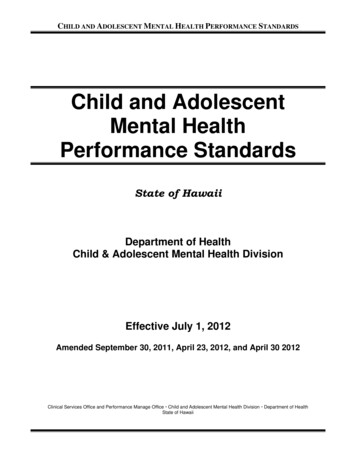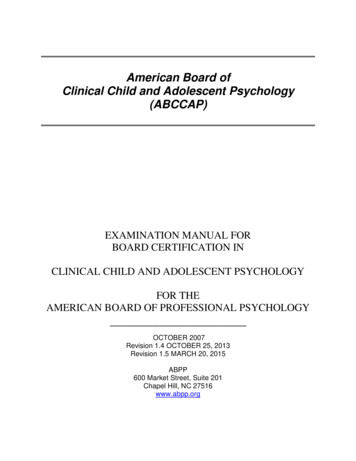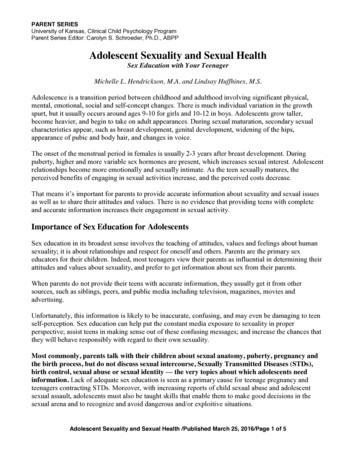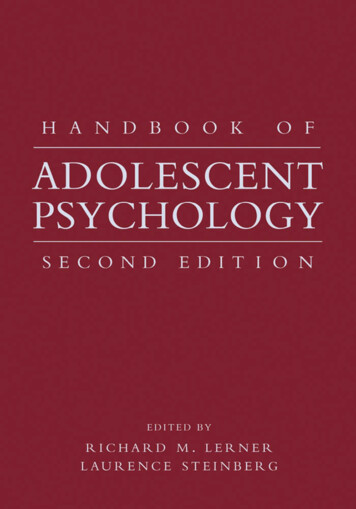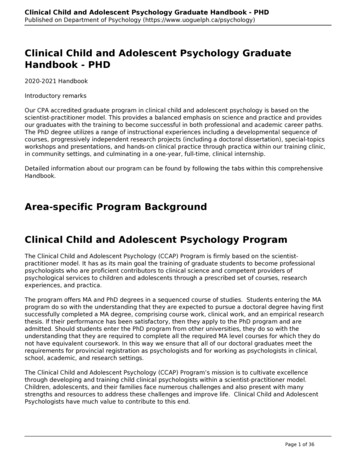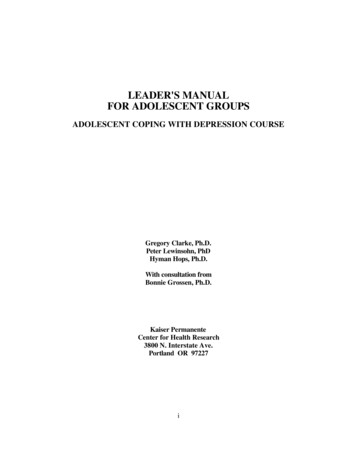
Transcription
LEADER'S MANUALFOR ADOLESCENT GROUPSADOLESCENT COPING WITH DEPRESSION COURSEGregory Clarke, Ph.D.Peter Lewinsohn, PhDHyman Hops, Ph.D.With consultation fromBonnie Grossen, Ph.D.Kaiser PermanenteCenter for Health Research3800 N. Interstate Ave.Portland OR 97227i
Copyright 1990by Gregory Clarke, Ph.D.10 9 8 7 6 5 4 3 2 1All rights reserved. No part of this book may be reproduced by anymeans, nor transmitted, nor translated into a machine language withoutthe written permission of the authors. Excerpts may be printed inconnection with published reviews in periodicals without expresspermission.ISBN 0-916154-20-3Printed in the United States of AmericaCopies of this manual and the associated workbook may bedownloaded from the Center for Health Research web site:http://www.kpchr.org/Original 1990 Edition CreditsEditor-in-Chief: Scot G. PattersonAssociate Editor: Margo MooreCopy Editor: Ruth CornellCover Design: AstrografixPage Composition: Margo Moore2000 Edition Credits:Conversion: Meagn MaguireWeb publication: Ed Reidii
ContentsAcknowledgements.viiPreface . ixIntroduction . 1SECTION I: Background and Overview. 9Chapter 1:Selecting and Training Group Leaders. 11Chapter 2:Assessment of Depression and Associated Problems . 15Chapter 3:Recruiting Participants . 23Chapter 4:General Issues in Conducting Groups. 31Chapter 5:Variations in the Use of the Course . 39Chapter 6:Theoretical Background . 43Chapter 7:Research Findings . 51Chapter 8:Future Directions. 57SECTION II: Course Sessions . 67Session 1:Depression and Social Learning . 69Session 2:Self-Observation and Change . 85Session 3:Reducing Tension. 101Session 4:Learning How to Change. 117Session 5:Changing Your Thinking . 133Session 6:The Power of Positive Thinking . 149Session 7:Disputing Irrational Thinking . 163Session 8:Relaxation. 181Session 9:Communication, Part 1. 195Session 10: Communication, Part 2. 209Session 11: Negotiation and Problem Solving, Part 1. 229Session 12: Negotiation and Problem Solving, Part 2. 243Session 13: Negotiation and Problem Solving, Part 3. 257Session 14: Negotiation and Problem Solving, Part 4. 269Session 15: Life Goals . 275Session 16: Prevention, Planning, and Ending . 285SECTION III: Parent Adolescent Sessions . 295Session 12: Negotiation and Problem Solving, Part 2. 297Session 13: Joint Parent-Adolescent Problem-Solving Session, Part 1 . 311Session 14: Joint Parent-Adolescent Problem-Solving Session, Part 2 . 321Appendices . 327References. 331iii
DedicationTo the adolescents, families, and colleagues who have helped us overthe years to develop this treatment program for depression.iv
AcknowledgementsMany talented people have contributed to the development of the AdolescentCoping with Depression Course. Foremost among these was Ms. Bonnie Grossen,whose many valuable suggestions have made the course more “teachable.” Themanuals also reflect the efforts of the therapists who helped to pilot and critique thepreliminary and current versions of the course: Paul Rohde, Michael Horn, JackieBianconi, Carolyn Alexander, Patricia DeGroot, Kathryn Frye, Gail Getz, KathleenHennig, Richard Langford, Karen Lloyd, Pat Neil-Carlton, Margie Myska, MaryPederson, Evelyn Schenk, Ned Duncan, Julie Williams, Julie Redner, Beth Blackshaw,Karen Poulin, Kathy Vannatta, Johannes Rothlind, Galyn Forster, Nancy Winters,Scott Fisher, Renee Marcy, Susan Taylor, and Shirley Hanson.We would also like to acknowledge that the concepts and techniques presented inthe course reflect the work of the following authors and researchers (among others):Aaron Beck, M.D., Albert Ellis, Ph.D., Marion Forgatch, Ph.D., Susan Glaser, Ph.D.,John Gottman, Ph.D., Gerald Kranzler, Ph.D., Lenore Radloff, M.S., Arthur Robin,Ph.D., and Irvin Yalom, M.D.Our sincere thanks to Scot Patterson and Margo Moore for their persistence andexpertise in editing and preparing this manual for publication; their assistance has beeninvaluable.v
PrefaceThis book describes the cognitive-behavioral treatment program that has beendeveloped by our research team for adolescent unipolar depression. The treatment isconducted with groups of four to eight participants who are 14 to 18 years of age, andthe vehicle for therapy is a class entitled the “Adolescent Coping with DepressionCourse.” During the sixteen 2-hour sessions, the adolescents learn essential skills forovercoming depression. The areas covered are relaxation, pleasant events, irrationaland negative thoughts, social skills, communication, and problem solving. Severaldifferent methods of instruction are employed: lectures by the group leader, discussions,role-playing exercises, and homework assignments. Research on the efficacy of thetreatment program has demonstrated that more than 70% of the adolescents who haveparticipated in the course are significantly improved one month after termination, andthat these gains are maintained up to 12 months after treatment.Depression is a debilitating disorder that seriously affects the lives of hundreds ofthousands of teenagers in the United States. Bouts of clinical depression also place theadolescent at risk for a number of associated problems such as academic difficulties andsuicide. In addition, social withdrawal and the other obstacles to social functioning thatoften accompany the disorder have a dramatic impact on many aspects of theadolescent's life at a critical time in his or her development. Although episodes ofclinical depression may gradually subside, the likelihood that these episodes and/ordepressive symptoms will recur is extremely high unless there is some kind ofintervention.Until recently, depression among adolescents has received very little attention, andthere have been few treatment resources available other than traditional psychotherapyand medication. The Adolescent Coping with Depression Course is a cost-effective,nonstigmatizing, psychoeducational intervention that can be used in a variety of clinicalsettings such as schools, mental health centers, and hospitals. It is our hope that thecourse will help to meet the need for an effective treatment program that is specificallydesigned for use with adolescents.vi
IntroductionIt is only during the last two decades that adolescent depression has become the focus of publicand scientific interest. Previously, depression was considered to be extremely rare or even nonexistentin children and teenagers (see review by Carlson and Garber, 1986). In recent years, however, severallarge-scale epidemiological studies have shown that clinical depression among teenagers is a significantproblem, affecting up to 3% of the general high school population at any one point in time (Kashani,Holcomb, and Orvaschel, 1986; Lewinsohn, Hops, Roberts, and Seeley, 1988). By age 18, up to20% of all teenagers have had at least one episode of clinical depression (Lewinsohn et al., 1988).These rates make depression the most frequently reported mental health problem for this agegroup.Early studies significantly advanced the nosology of affective disorders in children and adolescents(Orvaschel and Puig-Antich, 1986; Friedman, Hurt, Clarkin, Corn, and Aronoff, 1983; Chambers,Puig-Antich, Hirsch, Paez, Ambrosini, Tabrizi, and Davies, 1985). These and other studies havecontributed to the present consensus that the central symptoms of adolescent depression are similar, ifnot identical, to those of adult affective disorders (Kazdin, Sherick, Esveldt-Dawson, and Rancurello,1985; Strauss, Forehand, Frame, and Smith, 1984; Seligman, Peterson, Kaslow, Tanenbaum, Alloy,and Abramson, 1984).Unfortunately, recent evidence suggests that the prevalence of depression has been on the riseamong adolescents (Klerman and Weissman, 1989). For example, over the past two decades therehas been a 200% to 400% increase in the number of teenage suicides across the United States (Shafferand Fisher, 1981), which indicates there has been a similar increase in the rates of depressive disorder.Still other studies suggest a link between teenage drug/alcohol abuse, suicide, and depression(Lewinsohn, Hops, Roberts, and Seeley, 1988; Kandel and Davies, 1982). Certainly, the likelihood ofother coexisting disorders is markedly elevated in adolescents who have had an episode of affectivedisorder (Lewinsohn, Hops, Roberts, and Seeley, 1988). It is clear that depression among adolescentsis a major mental health problem, with numerous negative sequela and associated difficulties.Treatment of Adolescent DepressionIn contrast to these advances in diagnosis and nosology, there have been relatively fewinvestigations to date of the psychotherapeutic treatment of adolescent depression. Until recently,published accounts of the treatment of child and adolescent depression consisted exclusively of singlecase studies (Petti, Bornstein, Delemeter, and Conners, 1980; Frame, Matson, Sonis, Falkov, andKazdin, 1982). During the last several years, a few investigators have initiated larger experimentalstudies of psychological group treatments for depression in adolescents and children.2
IntroductionButler et al. (1980) focused on the school-based identification and treatment of depressed children10 to 13 years of age. Several different interventions were compared: 1) Role Play, which emphasizedsocial skills and problem solving; 2) Cognitive Restructuring, which focused on the identification andmodification of automatic and self-deprecating thoughts; 3) a teacher mediated attention-placebocontrol group; and 4) a classroom control group, which was never assigned to any intervention.Children in the Role Play group demonstrated the greatest decline in self-reported depression, while thechildren in the Cognitive Restructuring group showed evidence of a minor but nonsignificant trendtoward improvement. Children in the two control conditions failed to exhibit any significantimprovement.Reynolds and Coats (1986) randomly assigned 30 adolescents with elevated scores on the BeckDepression Inventory (Beck et al., 1961) to one of three conditions: a cognitive-behavioral treatmentprogram, relaxation training, or a waiting-list control group. The two treatment approaches were highlystructured and involved homework assignments and self-monitoring. Each treatment consisted of ten50-minute sessions conducted over a 5-week period. Subjects in both active treatments showedsubstantial and equal improvement; subjects in the waiting-list control group did not change significantlybetween pre-treatment, post-treatment, and follow-up assessments.While the results of these studies are encouraging, both the Butler et al. (1980) and Reynolds andCoats (1986) studies relied on self-report measures such as the Beck Depression Inventory or the ChildDepression Inventory to define their cases of “depression” (cases which may or may not have metDSM criteria for clinical depression). In addition, each study employed these same self-reportmeasures as the primary indication of treatment outcome. Conclusions regarding outcome werebased solely on patient self-report, which is often subject to various response biases. Expert clinicaljudgment, which is presumably less subject to error, was not included. At the very least, multipleperspectives (e.g., parent, child, clinician, and teacher) should be employed in evaluating outcome.Despite these shortcomings, the positive results of these studies are encouraging and suggest thatthe cognitive-behavioral techniques originally developed for use with depressed adults can besuccessfully adapted for use with adolescents and children in a group format.The Adolescent Coping With Depression CourseThe Adolescent Coping with Depression Course is a psychoeducational, cognitive-behavioralintervention for adolescent depression. The course is closely modeled after the adult Coping withDepression Course (Lewinsohn, Antonuccio, Steinmetz-Breckenridge, and Teri, 1984). While theadolescent course is very similar to the adult treatment program, the content has been modified andsimplified. The lectures and homework assignments have been reduced, and there is greater emphasison group activities and role-playing exercises. An earlier version of the course (Clarke and Lewinsohn,1986) consisted of fourteen 2-hour sessions which were held twice each week for seven weeks; thecurrent version (Clarke, Lewinsohn, and Hops, 1990) consists of sixteen 2-hour sessions conductedover an 8-week period.2
IntroductionThe course is designed for use with groups of four to eight adolescents as an after-school programand in other settings, or it can be modified for use on an individual basis. The treatment sessions areconducted as a class in which a group leader teaches adolescents skills for controlling depression. Theareas covered include relaxation, pleasant events, negative thoughts, social skills, communication, andproblem solving. Each adolescent is provided with a Student Workbook which is closely integratedwith course discussions and group activities. The workbook contains brief readings, structured learningtasks, self-monitoring forms, homework assignments, and short quizzes.The parents of the adolescents are encouraged to participate in the program to help foster andmaintain positive changes in the adolescents' moods. The course for parents consists of nine 2-hoursessions that are held once each week on one of the same nights as the adolescent group. During thesesessions, parents are given an overview of the skills and techniques that are taught to their adolescents.This promotes parental acceptance and reinforcement of the positive changes in their teenagers. Mostof the sessions for parents and adolescents are separate, with the exception of two sessions in whichthey practice problem-solving and negotiation skills as a family. Detailed guidelines for running theparent groups are provided in a leader's manual by Lewinsohn, Rohde, Hops, and Clarke (1990); aworkbook for parents is also available.An important feature of the course is that it is nonstigmatizing because the treatment is presentedand conducted as a class and not as therapy. It is a cost-effective, community-oriented approach thatcan successfully reach the great majority of depressed adolescents who typically do not make use of theservices of school counselors, therapists, and other mental health professionals.The Course SessionsThe course is presented as an opportunity for adolescents to learn new skills which will help themto gain control over their moods and deal with situations that contribute to their depression. During thefirst session, the group leader reviews the rules and guidelines for the course, the underlying rationale,and the social learning view of depression. The remaining sessions focus on teaching specific skills(relaxation, pleasant activities, constructive thinking, social skills, communication, and negotiation andproblem solving). Figure 1 provides a summary of the skill areas that are covered during each session.3
IntroductionFigure 1: Timeline of Skills and SessionsSessionSpecific Skill12345678Mood MonitoringSocial SkillsPleasant ActivitiesRelaxationConstructive ThinkingCommunicationNegotiation andProblem SolvingMaintaining GainsKey Skill is taught Skill is discussed as part of home practice4910111213141516
IntroductionRelaxation SessionsThe first relaxation technique presented is the Jacobsen method, in which participants alternatelytense and relax major muscle groups throughout the body until they are fully relaxed (Jacobsen, 1929).This relaxation technique is introduced early in the course because it is relatively easy to learn and itprovides the adolescents with an initial success experience; it is thought that this enhances their sense ofperceived self-efficacy (Bandura, 1981), which has been hypothesized to be a critical component ofsuccessful psychotherapeutic interventions (Zeiss, Lewinsohn, and Muñoz, 1979). The Benson methodis introduced about mid-way through the course; this relaxation technique involves sitting comfortably ina quiet place and repeating a word or phrase. Adolescents also learn a variation called the “quick”Benson that is more portable than the Jacobsen technique.Another rationale for including relaxation training is the well-demonstrated correlation and comorbidity between depression and anxiety (Maser and Clonniger, 1989), and the related hypothesis thatdepression and anxiety may be etiologically related disorders. If there is a causal relationship, providingtreatment for anxiety would assist adolescents in their recovery from depression.Many depressed adolescents also report experiencing tension and anxiety during social events andin other stressful situations. This anxiety often interferes with effective interpersonal functioning andreduces the pleasure derived from potentially enjoyable activities. Teaching depressed adolescents torelax in situations that are typically stressful enables them to implement the social skills they learn duringthe course and enjoy pleasant activities more (many of which are socially-oriented).Pleasant Activities SessionsThe rationale for including sessions that focus on pleasant activities is based on the behavioraltheory of depression developed by Lewinsohn and his colleagues (Lewinsohn, Biglan, and Zeiss, 1976).The primary hypothesis of this behavioral formulation is that relatively low rates of response-contingentpositive reinforcement (positive social interactions, pleasant activities, etc.) are a critical antecedent forthe occurrence of unipolar depression. This hypothesis emphasizes the importance of helping depressedindividuals increase their levels of pleasant activities, while at the same time decreasing their levels ofnegative or punishing events.Adolescents learn several basic self-change skills during the pleasant activities sessions. Theseskills include monitoring specific behaviors that have been targeted for change, establishing a baseline,setting realistic goals, and developing a plan and a contract for making changes in their behavior.Activities for each adolescent to increase are identified through the use of the Pleasant Events Schedule(PES) developed by MacPhillamy and Lewinsohn (1982).5
IntroductionThe PES contains a list of 320 potentially pleasant activities (e.g., “Taking a walk,” and “Reading abook”). An adolescent version of the PES is included in the appendix of the Student Workbook. Tofill out the schedule, each adolescent must go through the list twice. First, the adolescent rates eachevent according to how often it occurred during the past 30 days; the second time through the list, eachevent is rated for its actual or potential enjoyability. When the PES is scored, an individualized list ofpleasant activities is generated for each adolescent (note: a computerized scoring program for the PESis available from the publisher).Cognitive Therapy SessionsThe cognitive therapy sessions address the negative and irrational thoughts known to be associatedwith depression in adolescents. The approach is based on the theories of Beck (e.g., Beck, Rush,Shaw, and Emery, 1979) and Ellis (e.g., Ellis and Harper, 1961), which hypothesize that depression isboth caused and maintained by negative or irrational beliefs. The sessions incorporate elements of theinterventions developed by Beck et al. (1979) and Ellis and Harper (1961) for identifying andchallenging negative and irrational thoughts, although these techniques have been modified and simplifiedfor use with adolescents. For example, cartoon strips with popular characters (Garfield, Bloom County,etc.) are employed to illustrate negative thinking and the use of positive counterthoughts to disputeirrational beliefs. Through a series of progressively more advanced exercises, adolescents learn how toapply cognitive techniques to their own personal thoughts.Social Skills SessionsSeveral studies have demonstrated that depression is highly associated with poor social functioning,both in adults (e.g., Lewinsohn, Mischel, Chaplin, and Barton, 1980; Weissman and Paykel, 1974) andadolescents (e.g., Puig-Antich, Lukens, Davies, Goetz, Brennan-Quattrock, and Todak, 1985). Thislack of social skills may contribute to the onset of depressive episodes, and may also be involved inmaintaining and prolonging them. To address these deficits, the social skills sessions give adolescentsopportunities to learn and practice a variety of techniques such as active listening, planning socialactivities, and strategies for making friends. In contrast to the other content areas, the social skillssessions are interspersed throughout the course (see Figure 1), to ensure that they are integrated withthe other techniques and skills taught in the class (especially relaxation and pleasant activities).Communication, Negotiation, and Problem-Solving SessionsA unique aspect of the course is its focus on basic communication, negotiation, and conflictresolution skills (Sessions 9 through 14). The rationale for including these techniques is based on thehypothesis that familial conflict escalates as teenagers progressively assert their independence, and thatthe inability to resolve issues leads to negative interactions which may in turn contribute to or maintainthe adolescent's depression. The specific negotiation and communication techniques employed in thecourse are based on the ideas developed by Robin (Robin, 1977, 1979; Robin, Kent, O'Leary, Foster,and Prinz, 1977), Gottman (Gottman, Notarius, Gonso, and Markman, 1976), and Forgatch (Forgatchand Patterson, 1989), which emphasize the importance of good communication skills for effectiveproblem solving (Alexander, 1973; Alexander, Barton, Schiavo, and Parsons, 1976; Robin and Weiss,6
Introduction1980).The problem-solving sessions use a four-step model, based on Robin's (1979, 1981) approach: 1)define the problem concisely and without accusations, 2) brainstorm alternative solutions, 3) decide on amutually satisfactory solution through a structured negotiation process, and 4) specify the details forimplementing the agreement.The communication training involves feedback, modeling, and behavior rehearsal to correctnegative behaviors such as accusations, interruptions, partial listening, lectures, and put-downs. Theseare replaced with positive behaviors such as paraphrasing, active listening, “I” messages, good eyecontact, and appropriate body language.Life Plan and Maintaining Gains SessionsThe last two sessions focus on integrating the skills that have been learned, anticipating futureproblems, maintaining therapy gains, developing a Life Plan and associated goals, and preventingrelapses. Participants also identify the skills that they have found to be most effective for controllingtheir moods. With the help of the group leader, each adolescent develops an “emergency plan” whichdescribes the steps that will be taken to prevent depression in the future.7
SECTION IBackground and OverviewThe first section of this manual contains eight chapters that provide essential information regardingthe theoretical and practical considerations related to conducting the Adolescent Coping withDepression Course. Mental health professionals who are preparing to offer the course in other settingsshould read these chapters carefully. There are many issues involved in working with adolescentdepression that are critical to the success or failure of the program and the welfare of courseparticipants. Many of these important issues are examined in this section.Chapter 1 reviews the minimum qualifications for group leaders and the training models used in ourresearch program. The instruments and procedures for the assessment of clinical depression andassociated problems are described in Chapter 2. The focus of Chapter 3 is on strategies for recruitingparticipants, and inclusion and exclusion criteria. Chapter 4 considers some of the issues involved inconducting groups, such as fostering cohesiveness, developing trust and rapport, and dealing withattendance problems. Various possible adaptations of the course are discussed in Chapter 5. InChapter 6, the theoretical foundation of the course and clinical implications are examined. Chapter 7summarizes the research studies on the efficacy of the Coping with Depression Course as a treatmentprogram for adults and adolescents. Goals for future research are outlined in Chapter 8.8
Chapter 1Selecting and Training Group LeadersOur research group has trained numerous instructors to lead groups for adolescents and parentsduring the three outcome studies that have been conducted. Because our program was designed as aresearch investigation, we have developed strict recruitment criteria and training goals for our staff.Some of these criteria may not be appropriate in other settings such as clinics, private practices, andschool counseling offices. Nonetheless, these criteria and goals will be reviewed here to identifysignificant training issues that should be considered by other mental health professionals who are usingthese materials. We believe that the success of our treatment program is due in part to the effort wehave put into carefully selecting and training instructors, and that care providers in other settings willbenefit from our experience.Qualifications for Group LeadersGroup leaders must have a certain amount of relevant experience and training before attempting tooffer the course. The purpose of specifying the minimum qualifications that we believe are necessary tolead groups is to ensure that the course is conducted in a therapeutically responsible and effectivemanner. A broad range of mental health professionals would have the necessary skills, assuming theyhave had some training in the assessment and treatment of adolescent affective and nonaffectivedisorders. The list includes psychologists, psychiatrists, psychiatric social workers and psychiatric nursepractitioners, and counselors. Individuals who are not adequately trained for independent practice (e.g.,students, and teachers who do not have a mental health background) should only conduct the courseunder the supervision of a licensed mental health professional.Adolescents enrolled in the course regularly present many challenges beyond those addressed inthe Leader's Manual. Many issues that are critical to the success of the intervention are not covered,such as suicide risk assessment, group dynamics, and normal adolescent development. It is importantfor group leaders to have supervised training and/or experience in the following areas:1. Crisis assessment and intervention, especially with suicidal and/or substance-abusive youth(see Pfeffer, 1986; Rotheram, 1987; Trautman and Shaffer, 1984).2. Assessment of affective and nonaffective disorders (e.g., DSM). Group leaders must be ableto identify adolescents who would not benefit from the treatment program (exclusion criteriaare described in detail in Chapter 3).9
Selecting and Training Group Leaders3.4.5.6.7.8.Basic or intermediate training in any of the various cognitive-behavioral therapies, such ascognitive therapy (B
2 Introduction It is only during the last two decades that adolescent depression has become the focus of public and scientific interest. Previously, depression was considered to be extremely rare or even nonexistent




